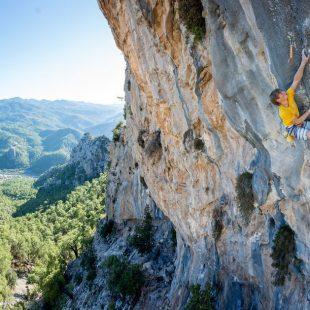
A large part of the success of any activity in the mountains, and even more so in skimo, lies in the previous preparation. The days before departure you must collect all the information you can about the itinerary, consult the ATES maps if they are available in the area, as well as the weather forecast and the avalanche danger bulletin of our route. But in this article we are going to focus on the requirements that you have to know in terms of the necessary material and the techniques of progression. These are some basic tips and techniques that you should know:
1 Technical equipment: the basics for any outing would be DVA, shovel, probe, helmet, headlamp, ice ax and crampons. If we anticipate an outing in which we need to rappel, we must also add the harness, safety carabiners, webbing rings and a simple rope (or Rad Line). If we are also going to cross glacial terrain, with the possibility of cracks. You cannot miss some ice screws, a crevasse rescue kit (consisting of Micro Traxion pulley, Tibloc, Partner pulley and cord) and lanyards.
2 When ascending a slope with the skis on the back, if it is not very steep, we can use the ice ax-stick technique, switching to two traction ice axes if the terrain is steep or with hard snow.
During the descent, it is advisable to keep the ice ax close at hand, for example under the shoulder strap of the backpack, so that we can easily access it in case of emergency.

3 When rappelling, if we are using a Reverso-type descender, with a very fine rope (for example, a 6 mm Rad Line cord), it is advisable to take two carabiners to connect with the harness and the Reverso, so that we its braking. In addition, we will use a self-locking knot to be able to perform maneuvers during the descent, controlling the rope at all times.
4 When going down a corridor, if you think your partner may have difficulties, it is preferable to stay above him, with the rope and the necessary material to belay him. To do this, find an anchor (rock ledge, tree, or dead body with the ice ax...) and, once secured, you can throw the rope with a carabiner so that the partner connects, thus helping him to descend.
The belayer is self-secured to the anchor and will remain in tension, limiting the possibility of impacts. Do not belay directly on the anchor if the resistance is uncertain (do it from the harness). It is recommended to use a dynamic knot for the descent, since it brakes in any position.
5 Progress through glacier terrain unroped: with skis, it is common to go unroped when progressing through glaciers. However, the rope must be easily accessible and ready to use. Be especially careful to properly prepare and store the rope to avoid knots, and attach a carabiner to the end. If a skier falls into a crevice, it is necessary to quickly send him a rope with a carabiner, so that he can quickly hook
6 Progress through glacial terrain while roped: if we are roped, we must respect a sufficient distance so that the belayer has enough space to carry out the arrest maneuver in the event of a fall of the partner. Each of the members of the roped party must have a reserve of rope with him (about 10 meters) to be able to perform the hoist. The rope must always be taut.
In a two-person rope, the recommended distance is a minimum of 15 meters; in a rope of three people, leave at least 8 meters between each one.
7 Rescue from a crevasse: if the partner has fallen into a crevasse, the person remaining on the surface will hold them as a counterweight and must quickly assemble an anchor to take the victim's weight off the ground. It can be an anchor with an ice ax or a ski buried in the snow, or with an ice screw. A ring will be connected to the anchorage, respecting the victim's axis of traction (checking that the strap is protected).
You will then install the MICRO TRAXION block onto the rope, in the proper direction for lifting, and then onto the anchor eye, gradually transferring the load to the MICRO TRAXION.
Once the victim's load is on the anchor, we must access the edge of the crack to assess the situation, before proceeding with the hoisting. Depending on the condition of the victim and their ability to collaborate, we will proceed to hoist them using a simple hoist or a double Mariner.
It is essential to be familiar with all these techniques so that, in the moment of urgency, we proceed to carry them out almost automatically. Before buying the latest ski model, consider investing in training courses that could save your life, and above all, do not stop practicing what you have learned.
You can see illustrations and videos of these and other fundamental maneuvers for ski mountaineering on the Petzl website.